Video
youtube
My Final Presentation for Open Studio
This project has acted as a catalyst for me to address a major problem in today's society, the one where everyone is too busy to enjoy the little things and are constantly living in an illusion of the future. The PEG is a product I have designed to help bring significance back into the moments that very few bother to care about anymore. It utilizes the connective society in which we live while also adding a personalized authenticity as you communicate your story in an intimate way. You are able to share the most precious moments in your life with whoever you chose, knowing that it will be a front row seat to the show of your life. You get to choose only one audience member but the journeys that you can share with them are limitless.
0 notes
Text
Story Board/ Script
The first step is to create storyboard script so I know how long to show my images and what I want to be showing.
-How are other similar videos formatted?- What are the key elements I want to highlight in this animation?Key points I want to highlight will be;
The purpose of the PEG
What it does
Why it does what it does
Why should people use it?
"The PEG is a transportable digital display card which updates via wifi. Each peg is linked to one device and the user sends photo's via the App to update their display card, wherever it may be. The intention behind the PEG is to create a physical connection to the virtual world. The PEG is designed to make an intimate connection between two people, where they can communicate their personal stories through photos.It works on a closed network basis which means that the displays only have the capability to receive and display information, not send and manipulate it. One of the key aspects that separate this from products already on the market is that; it intentionally has a limited amount of storage and can only retain one image at a time. Once the sender has updated the display with a new image, the previous one is intentionally deleted never to be recovered again. This ties into the origins of why I created the PEG, and by having a limited amount of storage, every picture is invoked with a lifetime. This finite lifetime that each photo has means that every moment is considered important and memorable and it emphasizes the authenticity and meaning of what the other person has decided to share with you. As the PEG's only bond with one device in their lifetimes, you as the user can rest assured that nobody else will interrupt your story because it only updates from you.
Imagine how cool it would be to have 5 pegs hanging on your wall, watching them changing and updating in relation to what your friends are doing at every moment.
I know I won't be able to stop people from taking photo's in nature but maybe this will help remind them to just enjoy the present and make the most of this moment right now
For more information about my Project and the process, I went through creating the PEG you can follow me on Tumblr at BCT-tailored technologies. Thanks for watching"
0 notes
Text
Presentation considerations
For open studio, I want to be able to express my project idea to the audience even though it is only a speculative design. I’ve decided the best way to explain what my project is (without having to create a physical product,) will be best portrayed through some form of visual communication.
I’m considering going with an animation approach but I lack experience in that field, plus, I’m weary of the time I have left in order to learn a new software then produce something nice enough for the open studio. I’ve considered other forms of visual communication from researching and found this chart of multiple different ways to communicate visually.

Interesting ideas but I think the PEG requires some visual movement in order to help express its capabilities. Creating emphasis on the most important parts while explaining what the PEG does, is going to require some form of recorded dialogue, so I’m thinking of making a video using a 2D animation style and just layering the recorded voice over the animation, similar to the crash course youtube channel.
-https://www.youtube.com/user/crashcourse
So to make sure I was choosing the best possible type of animation I started looking into how many different styles of animation there are out there and found this video really helpful in explaining the differences and highlights of each individual method.
https://www.youtube.com/watch?v=NZbrdCAsYqU
This was another tutorial that I found helpful in my research for learning the process of animation.
https://www.youtube.com/watch?v=5CZdTdMmp2w
I decided that animation is probably the best technique to use in order to describe and advertise my project so I started looking into different animation platforms to use and used this video and personal references of good animation software, as my compass towards selecting the right one.
I believe that Adobe Animate looks like the most user-friendly and easiest to grasp in the short amount of time I have left and I think I’ll use Filmore ( a video editing software) to play/edit the animation and then add the audio dialogue over the top.
Now to get into this 1.5hr long Adobe Animate tutorial and begin preparing my visual presentation for the PEG next week.
https://www.youtube.com/watch?v=3iXSQ8VcPcU
Reconsidering the difficulty and length of time it would take to use this animation software, I’ve found some nice simple 2D animation software called pivot which is stick figure based and looks really easy. I’ve also discovered a good explaining styled software called video scribe which honestly looks perfect for what I had in mind for my presentation video.
http://www.videoscribe.co/
Because this software looks much easier to experiment with and manipulate, I’m going to create a plan B for my presentation using this software just in case I run out of time using Adobe animate. Once I’ve got a working finished plan B, I’ll continue developing and making my plan A, just at least this way I’ll have something to submit if everything takes a turn for the worst.
0 notes
Text
Interactive Points
In this post, I will be covering the critical interactive points of my PEG. This is one idea I have invented to charge the cards, it acts as a power bank that you can slide the cards into, which will charge them via magnetic strips.
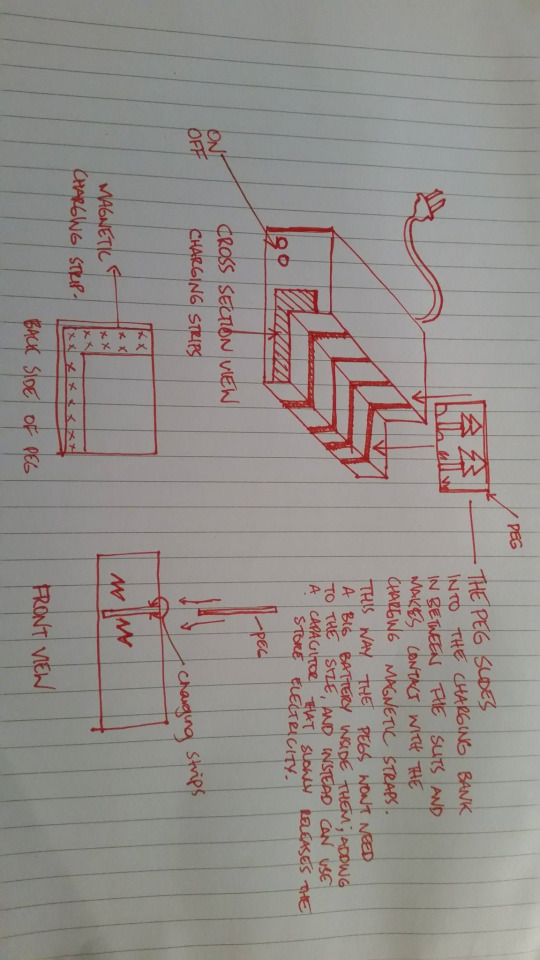
After exploring more possibilities of how I can display these images with the least amount of power consumption, Ricardo recommended me looking into the display technology behind the Kindle.The Kindle utilizes a technology called Electronic Paper which can hold static text and images without any ELECTRICITY USE!! This would be the ideal type of technology I would want to incorporate into my PEG instead of a traditional backlight LCD screen etc.https://en.wikipedia.org/wiki/Electronic_paper
Software - I intend to use a modified version of the wifi capable digital photo frames from my research, just slightly tweaking it so that it is only compatible with the device that is assigned to it once unpackaged.
Lifetime - The assignment of a PEG will be linked with the initial device that it pairs with when it's open. Once a PEG has bonded with the owner it cannot be reset or re-allocated to a new device. This is to ensure the security and authenticity of one's story. However if one seems to lose a PEG, and the charge on it is depleted for longer than 72 hours, the user will be able to Link their already assigned device to a new PEG, however this means that by default if someone finds the PEG that the user had previously lost, it will no longer update their story and will be wiped of it's last displayed image, becoming pretty much brand new.
Controls - I want the design to be sleek, easy to fit into a wallet and flexible in nature. Because of this, I am going to reduce all of the functions that the device can execute as a remote device and have the all of the control be done via the app on the device that it links with. By reducing the amount of functionality the PEG can perform, I ultimately reduce the amount of hardware and material needed to incorporate into the design. The electronic paper, wifi capabilities and battery are going to be the core elements that I'll need in order to perform the tasks of displaying and receiving photos.
Here's a brief flow chart of the user interface that the user will see once he downloads the App that pairs with the PEG.

I've decided that It will be essential to have an App to control the uploading and control functions of the device meaning that the cards will require minimum physical input and can be stored in enclosed places without having to worry about clicking a certain button to accomplish a basic function. I think this is a good idea to just have the cards as plain objects because once they're given to someone the person who receives it won't have to worry about physically interacting with it all the time.
This directs the emphasis of simply observing what the other person wants to share with you and I think the simplicity of the device itself adds to the nostalgic, finite expression that the PEG portrays. It makes it easier to just “have” a PEG instead of adding it to the list of stressors that you have to constantly interact with by having too many options. The point is to observe the other person’s story on a visual level, unlike Facebook where you feel the inherent need to respond to everything and everyone all the time.
1 note
·
View note
Text
Online Self Customization
After researching into the benefits of integrating the principles of OSC and CC identification, I began to see how my project already encompasses these attributes in its foundations.The PEG acts as a visual representation of your life so associating part of your identity into it is a part of its core purpose.
Whoever you decide to give your PEG to will receive exclusive and personal updates of your life, meaning that the device literally acts as a catalyst for you to choose whichever way you want to represent yourself in the eyes of the person who receives your PEG.
With the intention of sharing your story on a personal/intimate level the PEG enables deepening of connections the user has already made and could even be used as a way to create new connections between strangers with common interests.
The PEG will act’s as the link that you decide to make with another person as you create a bond with them by saying “This is my story, and I want you to be the one I share it with” I don’t think It could get any more personal in terms of acting as a catalyst for the user to identify with and relating to it as an extension of their self.
The customization aspect is open for development as I’m considering changing the PEG to be compatible with more file types than just photos opening up the possibility for a wider range of communicable expression. Also, I’ve considered changing the internal layout of the PEG so that possibly it can store 2 photo’s at a time, one taking up the majority of the display and the other acting as a small history window of the last image that was being displayed. This would be cool as it still maintains it’s original aspects of being temporary but now it would have a reminiscence factor to it as you can enjoy one last look at the photo before it disappears.
So with this in mind, I will move on to the next phase of exploring the interactive points of a PEG
0 notes
Text
Research
Since Snap chat is the most similar in nature to my project, I'm going to investigate into the cognitive principles of what makes it so popular and why it works so well as a concept.One psychological aspect that plays a part in the success of why snap chat works is the rule of reciprocation. The rule of reciprocation refers to our human need to respond to a positive action with another positive action, so when people send you snaps you feel obliged to send them one back before you forget what it was. This creates the hook for the App and later creates the initial stages for the habit of constant use to develop.
"INTERNAL TRIGGER" The fear of losing the moment.
"ACTION" Open the App and snap with just one tap
"VARIABLE REWARD" how does it look? Did I capture the moment? How should I Modify this?
"Investment" sending it to another user loads the next trigger and stores the value when new contacts are added
"External Trigger" Replying to a snap sends a new notification, activates the rule of reciprocity....and the Hook cycle continues.
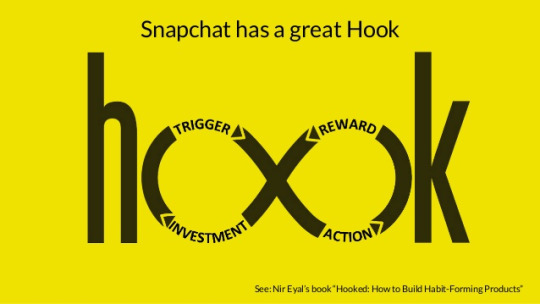
https://www.slideshare.net/nireyal/the-secret-psychology-of-snapchat/45-Following_this_rule_when_a
After reading through this page it made me want to explore more about what cognitive processes are going on in the minds of technology based consumers when they become hooked on a product. From the page below I found that a couple of social psychological principles play a part in the success of how a new product will be received and why people tend to become hooked on certain ones more than others.
- Social comparison and self-esteem increase.
- Fear Of Missing Out
- Social validation
- Ego
- Social comparison and self-esteem
increasehttp://www.keepitusable.com/blog/?p=2568
I wanted to explore some of the deeper reasons behind these basic principles so I used the AUT student library to find some academic journals in hopes of finding some studies and information on what is happening between the user and the application/product which keeps the user coming back.
Antecedents and consequences of consumer-customized product identification and the role of product involvement
http://www.sciencedirect.com.ezproxy.aut.ac.nz/science/article/pii/S0747563217302947
It deeply explains people's need for "Online Self-Customization" and it's importance for consideration when designing any kind of product or interface.
"Online self-customization (OSC) enables customers to design a product tailored to their preferences and needs via the online platform. This study mainly argues that a successful OSC experience goes beyond simply increasing a consumer’s preference fit; it provides an opportunity to develop a meaningful relationship with customers by allowing them to embed their sense of self into the customized products and thus identify themselves with the products. Consumer-customized product identification (C-C identification) was proposed as central to our understanding of why and under what conditions OSC processes enable consumers to articulate their identities. “
"Consumers attempt to signal their sense of self through product consumption (Belk, 1988 ; Kleine et al., 1993). Levy (1959) first noted symbolic meaning in consumption in which “people buy products not only for what they can do but also for what they mean”. In this context, OSC is viewed as a means of integrating important aspects of the self into the products, beyond simply increasing preference fit. Not surprisingly then, a recent research has focused on identification (i.e., the degree to which one perceives a customized product as a representation of his/her identity) as an important psychological mechanism underlying consumer responses to the customized product "
The article goes into explaining and touching on many interesting dimensions behind consumerist thought patterns. I'm going to focus on this idea of OSC and try to implement it into my project as coherently as possible so that my users can think of my PEGS as a physical and virtual representation of themselves, hopefully keeping them enticed and identified with my idea. http://www.sciencedirect.com.ezproxy.aut.ac.nz/science/article/pii/S0747563217302947
0 notes
Text
Feedback and Considerations
To make sure that I hadn't bitten off too much to chew with the difficulty of this concept and the time restraints of the assignment, I touched base with Ricardo to get some feedback on what he thought of my initial Idea. I was already worried because of my technical difficulties and my lack of knowledge in robotics and so on and didn't want to have to invest half of my time learning a new skill in order to use it for just a single dimension of my design. Ricardo helped me see that trying to physically create this idea wouldn't be feasible with my current skill sets and time restrictions, however, developing and constructing this idea as a speculative design, as I had already planned to do, would work. As this was my first attempt at using speculative design to express my ideas I asked for some advice on how to begin the process and Ricardo gave me some valuable parameters to follow and explore to get started on the right track.
Some of the areas he recommended exploring were-
-Create a storyboard system (refer to the last blog post for picture of the system)
-Explore and engage in the reasoning behind why similar products have worked in the past.
-What is going to be the critical interactive points if this was made?
-Tests, Body storming, and feedback, (however because this is going to be a speculative design, physical testing is out of the equation, therefore, I'll be relying on feedback to help lead the development of my idea. ( I remember one lecture in the studio, someone was talking about testing a robot on the south side to help teach the students. The story kinda went off on a tangent but it was insightful because whoever was talking, starting getting into the importance of which questions you ask and how it's easy to prime someone into giving you good feedback which is what most people consider a good thing however good feedback isn't helpful for constructive improvements. Also, they made a point into the importances of who you test your products on, avoiding family members like your mother because they will just say everything is awesome. One final point that sunk in deep with me was that children are great test dummies because they are so straight up and honest and won't hold back on the criticism. So to cover all bases I'm going to ask as broad of a spectrum of people for feedback as possibly and expand the range of question I ask them, hopefully, this will lead to the best development of my idea.))
My first Guinea Pigs for testing
To provide clarity of how these feedback interactions went, I randomly asked if people wanted to provide me with some feedback on my project idea. I explained to them how it would intend to work if it was physically made explained one potential aspect of the project and then asked them what their thoughts on the idea was, I did ask them to be as honest as possible as well to help bring down the social convention of just giving good feedback.
One user liked the simplicity of only being able to receive photos, in contrast to being over complicated and orientated around a lot of different types of files at once. E.g sound, video, GIF.
The other thought it was a good idea, however, he brought to light a very important piece of information to which I wasn't aware. IT HAS ALREADY BEEN DONE BEFORE. (within reason) A critical part of the research phase he told me he practices was, before getting too far into a project is that it's a good idea to Google it first to see if it's been done before, and also to see what's out there that's similar in nature. Pretty simple and plain but I failed to do it.
The third person really enjoyed the concept behind the idea and compared it to the changing portraits in Harry Potter which I thought was a big up.
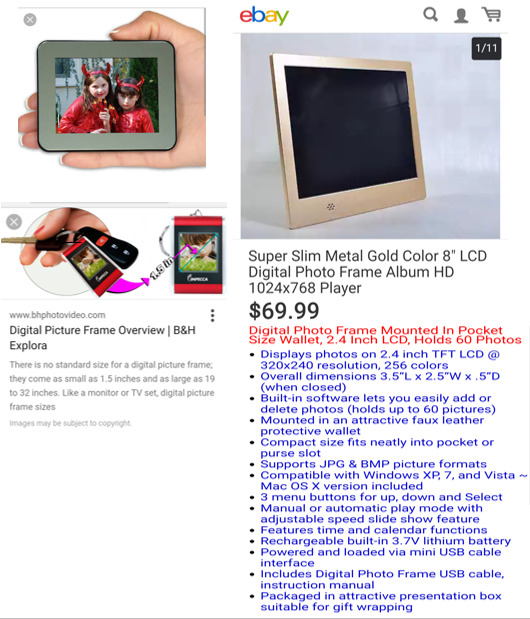
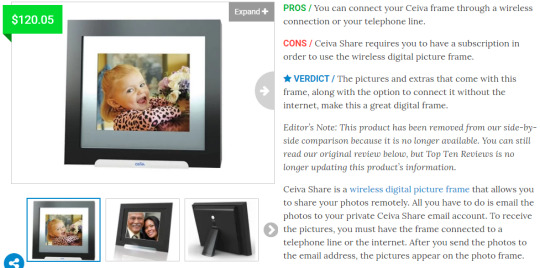
After taking a peek at what's already out there I found several products which could send and display pictures on a small LCD screen similar to my idea. They have even been made with transportability in mind and can fit into your pocket while retaining over 30 images at once! I began to get disheartened after discovering this and starting contemplating what my idea has to bring to the table and what is different about what I'm trying to create in light of these already existing products.
Clint provided me with a well-needed pep talk on some of the aspects he thought were individually attributed to my project and helped me see the differences between them such as;
1-The idea that it can fit into your wallet picture holder
2-That it's flexible and bendable
3- That it utilizes a closed network
4- That it confronts a personal issue I have with people taking their phones out to take photos instead of enjoying the moment.
The best and most similar product capable of performing the tasks I want the PEG to do is the Cevia Share(pictured above). So using this as the benchmark for comparison, I'll run through a few core principles that I believe differ from my PEG to this impressive digital photo frame.
In contrast to the core purpose of a digital photo frame of displaying photo's, the PEG has the core design pillar to "Act as a medium between the virtual and physical worlds" This means that its purpose is linked to more in-depth function and that it is defined by the potentials and capabilities of what it has to offer. I will continue to describe these attributes below.
While all of these digital photo frames make an effort to maximize their storage capabilities, storage is intentionally limited to one photo at a time with the PEG. The artifact will be able to cache the image in a temporary memory dump and will be able to retain them even after it has gone flat or left wifi range. Limited storage is a core design principle to the PEG as it means that every time a photo is taken and sent to be displayed, it's life begins. You never know how long this image will last and you will never be able to recover it once it's gone, thus the PEG acts as a physical analogy of the nostalgic impermanence of life and all it's unique and precious moments that come and go.
The ultimate direction I would want to take this idea towards would be best communicated by a visualization exercise. Imagine giving out 6-7 of these cards to your friends and significant other, constantly updating them in real time with a physical and virtual picture story of your life. Then imagine further, that you have a blank wall in your room which you attach all the cards you've received from your friends in a nice cluster. You would be able to watch each individual's life through pictures updating and changing right in front of your eyes in real time while also retaining and holding the image until it’s updated again. You would be able to share your experiences with others to a new extent by taking their digital stories and transferring them onto a physical platform.
The PEG adopts the principles of a connected network while simultaneously adding a personal dimension to the field. Unlike Snap Chat where you can send photo's to a large group of people at any time and you don't really know whether or not the message is unique to you, the PEG operates on a closed network basis as it can only receive photo's from one device during its lifetime. This means that no matter where you are in the world, once you've given someone your PEG you can rest assured that no one else will interrupt your story because it's uniquely just for you. Therefore a collection of 5 of these cards means that every single PEG is a unique story which is being shared specifically with you like no one else's. This is how it touches on aspects of an instant photo because once you give someone an instant photo it's a captured memory that can be taken wherever you go, although in this case, the peg goes with you and the flow of memories that it displays only lasts momentarily creating a temporary window into the sender's life.
My next phase of exploration will be looking into what makes photo sharing Apps so successful and how I can adopt those same principles and entwine them into my project
0 notes
Text
Origins of my Idea for Open Studio The "PEG"
Foreword and my reasons behind the birth of this project idea.
Traveling has always been a big part of my life, experiencing nature and exploring the wilderness fulfills an innate yearning in all of us, and for me, it creates an anchoring peace and balance within my being. In my opinion, the act of experiencing nature should be something intimate and memorable, but to my experience, all people ever want to do is take photos of the scenery to reminisce on LATER, and use them to brag to their friends about their latest accomplishments. By doing this, I believe people fail to embody the full experience of memorable moments and don't even put the effort into remembering them because they have become so reliant on technology to do the recalling for them. The experience becomes diminished from the memory of an awe-inspiring view and experience to a junk data file that's been in their backup drive labeled "travel photos" for the last 3 years.I do understand that being able to take a photo is great for sharing your experiences with family and remembering after years of time what a magical moment that was but for me I feel like the most important part of any experience is that first moment when your mind shuts off and you fully immerse yourself in the view. Photo's detract from the beauty of this impermanence that you experience because you always have the niggling suggestion in the back of your mind that "I can see this later" or "I'll just look through my photos when I have the time" thus you never really immerse yourself in the moment missing the whole point of the journey. So in spite of everyone robbing nature of its moment, and the lazy attention of those who religiously take photo’s, I have decided to create the might PEG.
So what is the "PEG"?
The "PEG" is a WiFi updating, instant photo sized & shaped card that tracks your friends lives by displaying their photos in real time. It will update and replace the last image the sender had shared with their most recent upload, creating a momentary window into the life of the sender which the receiver can only experience once, emphasizing the nostalgic impermanence of every experience by giving it a finite lifetime. The card will be able to store the images in a memory cache and will remember them even after they have run out of battery and WiFi signal. However, once the card has been updated with the latest photo, the old one will be deleted intentionally making every photo shared uniquely important.
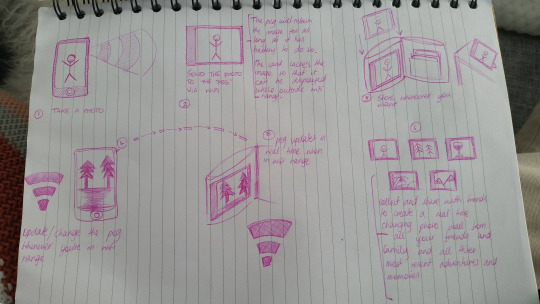
0 notes
Text
Premises and Origin for my Final Project
I have decided to integrate aspects from my Cards for play & Spaceship 2050 briefs, to act as the building blocks for my final project. From the Cards For play Brief, I will be revisiting the idea of " Design and make a deck of cards that encourage, frame or facilitate play." However, in this project, I want to have less emphasis on play and instead want the project to lead more towards a set of cards that act as a medium between the virtual and physical worlds. From the spaceship 2050 brief, I will be extracting the idea of a speculative design, to explore the explain the theories and possibilities behind my final project, without necessarily needing a physical representation of it.
0 notes
Text
Reflective Journal
At the beginning of the course, my difficulties in reflective processing were routed in my tendencies to overanalyze and my fear of failure.As this was the first time I had ever used a blog before, I wasn't familiar with the formats and procedures that conventional bloggers used and I wasn't even sure about how to use Tumblr, let alone create informative and reflective blog posts. My biggest struggle was overcoming the fear of making a mistake and not getting everything right all at once. I was initially very anxious about how I should post, what content I should be covering and whether or not I was doing enough or even on the right track. I started to develop a negative feedback loop as I constantly compared my work to others in the class and would fixate on what I thought I was doing wrong instead of what I was doing right, which made it difficult for me to explore and develop my ideas enthusiastically. As I began to fall behind because of my difficulties with time management, I started paying more attention in the ICT classes and started asking for more feedback from my mentors. With the new information and feedback I received, I got over the initial stages of worry about whether or not I was doing the right thing and decided that I would adopt the core principle of the course to "fail faster." I realized that no one was going to do the work for me and that it was time for me to take responsibility to try my best even if it didn't always end how I had initially intended.
Thus I began developing my skills in the iteration, I started creating prototypes quickly to see what an idea had to offer, what could be improved and what were some of the trouble that I discovered from making a physical model. Learning to be brave enough to just try and let go of the outcomes was a big step for me in this first semester. By letting go of the outcome, you create space in your mind to explore the idea in critical and creative ways which turn the task into more of an experiment, which in my eyes is more enjoyable to participate in.
During the sound project, I was beginning to understand the processes of divergent and convergent thinking while I was exploring the different models for my instrument. I discovered the benefit of exploring a range of possibilities then narrowing my sights to develop an individual aspect of the piece. This helped with exploring new possibilities quickly and effectively as I learned from every iteration.
REFLECTIVE AND CRITICAL THINKING REVIEW
Reflection for the purpose of documentation and box ticking is the mindset I had as I began the course. It wasn't until I began the sound project that I began to understand that the reflective practice of blogging helps to open up room for insight and understanding. It's supposed to be used as a tool to help refine ideas and critically evaluate your most recent actions, acting as a compass for progress on your journey to the end.
Finally looking back at my reflective progress I believe one thing that really held me back and took an extra while to understand; was that when a task seems too big to approach, break it down into little chunks.This is probably one of the most valuable pieces of advice that Clint and Jacques gave me marked my progress start point for the semester. 9/10 of the times, my anxiety about what to do and how to do it was simply caused by the monumental illusion of difficulty that I would perceive a task to be. Without even knowing how or why I was finding it difficult to begin, subconsciously it was the fact that there was just soo much complexity involved that I would give up prematurely because I didn't think I could accomplish the task. Breaking the big problem into bite-sized pieces is what has allowed me to begin the improvement progress and push past my regular boundaries as I'm now able to take problems and break them down into accomplishable tasks, similar to how I began writing this reflective post.
FUTURE IMPROVEMENTS/THINGS I HAVE LEARNED
-Time management and task management. This one is pretty obvious and in the future, I hope to strongly strengthen my abilities to maintain a consistent and constructive workflow on my future tasks.
-I would often research at the wrong times in my creative process. In hindsight I realize that research is one of the vital elements of the creative process, it allows you to peer into the world and see what is already being done, what is similar to what you are trying to make, and fuels the potential for creative reinvention. By doing this you are saturating your mind with more pathways for exploration and creativity.
-Consistent effort. Looking back, I feel like simply doing "more" work isn't going to help you grow as much as doing quality work consistently. For me, quality work is taking the time to set time blocks aside for certain tasks and not stopping until it's reached the expectations of your best work. Even when you don't really want to do it for whichever reason, just having that repetition of effort is what is going to make the most improvement in the long run and lead to the best results on the journey to self-development.
As you begin to develop a routine of always producing your best work, or at least making an effort to, you will find that in times of stress and deadlines you will be more prepared to perform because you have trained your mind to push through the mental struggle.
Over the period of this course, I have developed my abilities to inspect, research, critically evaluate, iterate and communicate my ideas. I look forward to refining my work ethos and develop more insights and tools to benefit my future endeavors on the journey to becoming a Creative Technologist.
1 note
·
View note
Text
The Final Cut
Shot Lists. Made by Eden
https://drive.google.com/file/d/0B9-QjDMsUxsbUzVTMm1SdVFLcFk/view
Movie Links Youtube
https://www.youtube.com/watch?v=mon09CezfRA&feature=youtu.be
Soundscape. Made by Sam Walness
https://soundcloud.com/prestonbct/straydream
Script by Adam Perry
which can be located on his blog @pezbct
Work contribution / role
My role in the group was that of a producer, I helped to manage the workflow, delegate roles, keep our groups times organised to be as productive as possible and made the storyboard. I also created the tagline and helped film shots whenever possible.
Film process reflection
After capturing the last few shots we needed on Friday, Adam, Sam and Eden finished the last pieces of editing for our film, adding the special FX and changing the colour gradient of both characters. We also got some vital feedback from Ben Kenobi regarding the intentions behind the glasses and what exactly the storyline was aiming to represent. This led to an important discovery in our story refinement as being questioned about the significance of the glasses and what the purpose behind wearing them was, I realised that we had a few finer details to sort out regarding the actual purpose and intentions behind wearing the glasses.
After some reflection about what the story is trying to portray, I began to realise that having a film shot in the first person means the direct meaning behind the shots is subjective to interpretation and can be different to every person. However following the direction of our tagline
“ Experience life from both sides of the lens in a world where ignorance is reserved only for the wealthy. “
I remembered what I had initially interpreted the meaning of the glasses and the film to be about. The glasses to me represent a “rose tint” on everyday life. They make the problems of the day seem less visible because people are soo enveloped in their augmented reality, that they don’t even see the current state of the environments around them. It has become a daily ritual in 2050 for those who can afford the glasses, to go about their days with a relaxed naivety as the glasses change the environment around them to appeal more pleasing. We created this film in the split screen because contrasting the lifestyles between the character with glasses to the one without, helps the viewer to identify the actual difference in lifestyles and the characters perceptions of their environment.
This is a good analogy for what’s actually happening to a huge amount of the E-Waste dumpage in today’s society. With peace of mind and luxury at the foremost of importances in our lives, we choose to turn a blind eye to the effects that our greed and over production has on the world and thus in a way, we put our own glasses on as we choose ignorance and freedom from responsibility, instead of consciously making a difference in the way we consume and dispose of our electronic wastes.
As long as the audience member reads our tagline caption before watching the movie, have an open mind and strong focus, I believe the meaning behind the glasses is pretty self-explanatory through the contrast in different lifestyles, colour gradients and of course, the audio played down in the background.
Final Opinions on Work Process
I really enjoyed working with my Group members Sam, Adam and Eden. They were all very talented and hard working in their own areas of expertise and I felt overall our group had a really straight up and fluid workflow from the beginning. It was a new experience for me making a movie as I don’t have any experience doing any of the tasks that we were attempting but my group were patient and really easy going in terms of work delegation and time management. It was also the first time I have taken on a leadership role in a small film orientated group and because I really didn’t know much about editing, or special effects I felt like I wasn’t able to contribute as much as I would have liked to towards the group. Because of this I made sure to accomplish as many small jobs as possible to mitigate the workload on my teammates and I think because of this in conjunction with all the effort and hard work everyone put in, is the reason why we created such an awesome movie.
0 notes
Text
Logline
“ Experience life from both sides of the lens in a world where ignorance is reserved only for the wealthy. “
As we near the ends of production, we only have a handful of tasks left to finish until our movie “blind side” is complete.
I feel like this logline nicely summarises the messages we are trying to portray in our film, as reality is physically the same for both protagonists but perceived completely differently.
2 notes
·
View notes
Text
Final shots
Adam and I went out today getting the last few train scene shots that we needed, while Eden and Sam stayed back and edited the film we have. The way we are going right now, we almost have all the shots for character 1 (without the glasses) and now need to focus our efforts on adding the pop-up shots, E-Waste interviews and sound effects to make up character 2′s story.
It’s hard to stay positive without seeing the story of our main character developed and finished. I know once we get all the effects edited and compiled the contrast between the two will be golden and the film will all fall into place but as for right now, it looks like a simple day time routine montage at the without a story line or dialogue. Fingers crossed we push through the last few hours of editing.
0 notes
Text
Visual Representation of VLOG
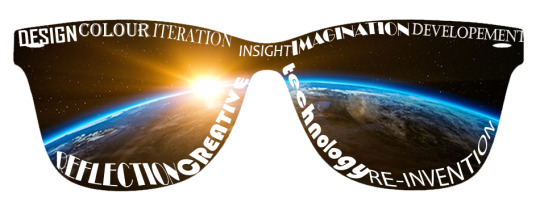
I’ve decided to create a typography styled poster to embody the idea that we as creative technologists see the world from a new point of view. We have the tools from design and computer science to reinvent the wheel and see things from informed critical vantage points.
0 notes
Text
Communicate your video in a visual format
Instead of going with a regular poster to communicate the message in my VLOG, I’ve decided to stretch the boundaries and go with an image/typography based representation.
I like this idea of using text to shape a face, the face has the potential to portray several emotions and expressions and this will help to connect the image to the audience. The human mind can interpret and recognise faces within milliseconds as it scans for all the micro-expressions in the faces structure and composition.
Using a face will in a way, trick the viewer into looking deeper into the undertones of my typography design as their mind will scan the page, detect a face then subconsciously look deeper into the details of the face and the content that makes them up.
My target audience will be young students at AUT who are looking for thought provoking content and my poster will act as a visual representation of what I believe Creative Technologies is comprised of. I will be using keywords which represent creative technologies in the build up of my face to create two layers of meaning symbolic meaning.
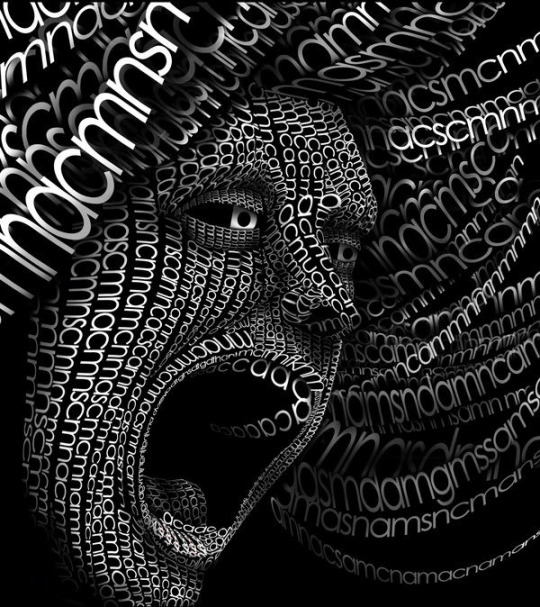
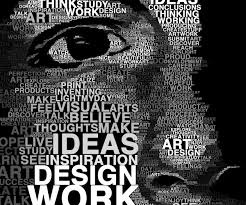
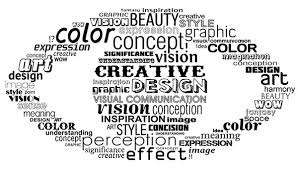
0 notes
Text
Filming Day 1
We filmed a big majority of our indoor apartment and outdoor walking scenes today, filming what we could with the remaining time we had left in the day. Due to time restrictions, we had to set an agenda for what we were going to focus on and so we initially started out with the indoor apartment shots which will be at the beginning and the end of our film. Because our film will be shot in split screen, we required 2 different apartments both representing different environments of our characters but because we couldn’t use the second one on the day we only got half of what we needed.
Ideally, we would have wanted to get all the filming done in chronological order from start to the end of the film but instead, we made do with the environments we had and got to work.
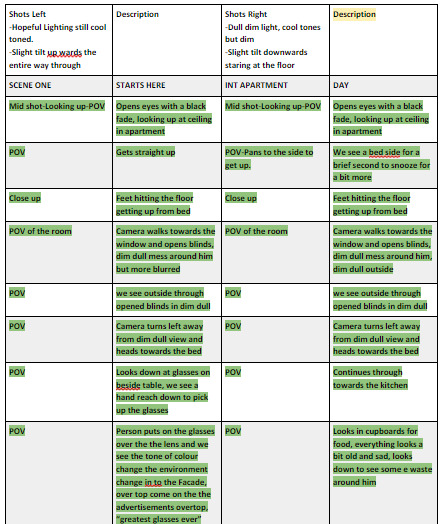
This right here is our bread and butter, without this shortlist we wouldn’t have been able to get half the amount of filming done (Thanks, Eden).
After we had captured as much of the outdoor and indoor scenes as possible, we only had 2 environments left to film, the second apartment and the train station. As the day was coming to and end and I had plans to be somewhere, we checked which scenes were left and made a plan for the weekend. Sam and Adam were going to get the last apartment and garden scenes so that on Monday all we had to worry about was the train station.
As the cutting/editing phase will occupy the majority of our time, I as the producer will push to get everything out of the way as fast as possible to allow enough cushion time for our team to edit. Because we have gone with a film with no diegetic dialogue, the visual communication needs to be on point if we hope to portray our message. Editing is a unique skill to have and I am worried that because 3/4 of us don’t know how to do it, the workload won’t be spread equally and because of the time frame being so small, I'm worried the time pressure mixed with the responsibility of having to edit all the footage before Thursday, may prove to be too overwhelming and strenuous to complete.
As I haven’t got any background experience in editing, I will try my best to relief some pressure on our editor; whom I think at this stage is Eden, as she’s the only one with experience in the matter, by completing as much of the other aspects of our film as possible.
0 notes
Text
Day 3 Production
Today we met to bring the design stage to a close and prepare to enter the production phase. Here’s a picture of our story board based off our script.
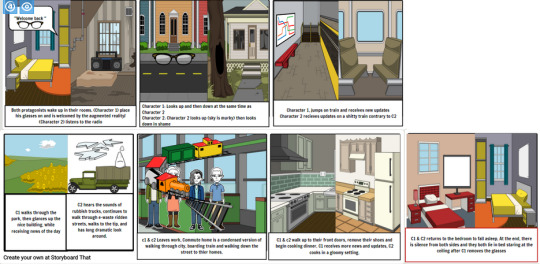
After going through our current position, the last piece we needed to begin producing was to have a list of the shots we were going to use. Eden created our shotlist and revamped our scipt, adding more detail for the scenes we are going to emphasis by using certain camera techniques.
I quickly drafted out a story board to act as a refrence to use on the go, for the angles we will be using during indoor scenes.


To ensure that we have a smooth filming session tomorrow, I’ve mocked up a production schedule along with a populist so that we can get as much filming done as possible, to allow for cushion time when we edit.
Here’s a list of some news and other forms of information to be used on screen in our film.
http://www.sbs.com.au/news/dateline/story/e-waste-hellFirst thirty seconds of
news report on the problems of e-waste in AUS
First 30 sec for news reporter on E-waste pandemichttps://vimeo.com/23173121
Consumerism .27 -.37 pandemichttps://vimeo.com/23171839
0 notes